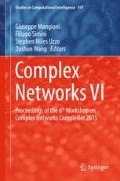Abstract
Hyperbolicity is a global property of graphs that measures how close their structures are to trees in terms of their distances. It embeds multiple properties that facilitate solving several problems that found to be hard in the general graph form. In this paper, we investigate the hyperbolicity of graphs not only by considering Gromov’s notion of δ-hyperbolicity but also by analyzing its relationship to other graph’s parameters. This new perspective allows us to classify graphs with respect to their hyperbolicity, and to show that many biological networks are hyperbolic. Then we introduce the eccentricity-based bending property which we exploit to identify the core vertices of a graph by proposing two models: the Maximum-Peak model and the Minimum Cover Set model.
Access this chapter
Tax calculation will be finalised at checkout
Purchases are for personal use only
Preview
Unable to display preview. Download preview PDF.
References
Abu-Ata, M., Dragan, F.F.: Metric tree-like structures in real-life networks: an empirical study. arXiv preprint 3364(1402) (2014)
Adcock, A., Sullivan, B., Mahoney, M.: Tree-like structure in large social and information networks. In: ICDM 2013 (2013)
Albert, R., DasGupta, B., Mobasheri, N.: Topological implications of negative curvature for biological and social networks. Physical Review E 89(3) (2014)
Baryshnikov, Y., Tucci, G.: Asymptotic traffic flow in a hyperbolic network. In: ISCCSP (2012)
Borgatti, S., Everett, M.: Models of core/periphery structures. Social Networks 21(4), 375–395 (2000)
Bu, D., Zhao, Y., et al.: Topological structure analysis of the protein-protein interaction network in budding yeast. Nucleic Acids Research 31(9), 2443–2450 (2003)
Butland, G., Manuel, J., et al.: Interaction network containing conserved and essential protein complexes in escherichia coli. Nature 7025(433), 531–537 (2005)
Chepoi, V., Dragan, F., et al.: Diameters, centers, and approximating trees of delta-hyperbolic geodesic spaces and graphs. In: SoCG 2008 (2008)
Chepoi, V., Dragan, F., et al.: Additive spanners and distance and routing labeling schemes for hyperbolic graphs. Algorithmica 62(3), 713–732 (2012)
Christian, V.M., Krause, R., et al.: Comparative assessment of large-scale data sets of protein-protein interactions. Nature 6887(417), 309–403 (2002)
Cvetkovski, A., Crovella, M.: Hyperbolic embedding and routing for dynamic graphs. In: INFOCOM 2009 (2009)
Da, S., Rosa, M., et al.: Centrality, network capacity, and modularity as parameters to analyze the core-periphery structure in metabolic networks. Proceedings of the IEEE 96, 1411–1420 (2008)
de Montgolfier, F., Soto, M., Viennot, L.: Treewidth and hyperbolicity of the internet. In: 10th IEEE International Symposium, NCA, pp. 25–32. IEEE (2011)
Duch, J., Arenas, A.: Community detection in complex networks using extremal optimization. Physical Review 72(2) (2005)
Fell, D., Wagner, A.: The small world of metabolism. Nature Biotechnology 18(11), 1121–1122 (2000)
Gromov, M.: Hyperbolic Groups. Springer, New York (1987)
Holme, P.: Core-periphery organization of complex networks. Physical Review E 72(4) (2005)
Jeong, H., Mason, S., et al.: Lethality and centrality in protein networks. Nature 6833(411), 41–42 (2001)
Ma, H., Zeng, A.-P.: Reconstruction of metabolic networks from genome data and analysis of their global structure for various organisms. Bioinformatics 19(2), 270–277 (2003)
Ma, H.-W., Zeng, A.-P.: The connectivity structure, giant strong component and centrality of metabolic networks. Bioinformatics 19(11), 1423–1430 (2003)
Milo, R., Shen-Orr, S., et al.: Network motifs: simple building blocks of complex networks. Science 5594(298), 824–827 (2002)
Modha, D., Singh, R.: Network architecture of the long-distance pathways in the macaque brain. Proceedings of NAS 107
Narayan, O., Saniee, I.: The large scale curvature of networks. Physical Review E 84(6) (2011)
Négyessy, L., Nepusz, T., et al.: Prediction of the main cortical areas and connections involved in the tactile function of the visual cortex by network analysis. European Journal of Neuroscience 23(7), 1919–1930 (2006)
Rain, J.-C., Selig, L., et al.: The protein-protein interaction map of helicobacter pylori. Nature 6817(409), 211–215 (2001)
Rodríguez, J., Sigarreta, J., et al.: On the hyperbolicity constant in graphs. Discrete Mathematics 311(4) (2011)
Shavitt, Y., Tankel, T.: On the curvature of the internet and its usage for overlay construction and distance estimation. In: INFOCOM 2004. IEEE (2004)
Author information
Authors and Affiliations
Corresponding author
Editor information
Editors and Affiliations
Rights and permissions
Copyright information
© 2015 Springer International Publishing Switzerland
About this paper
Cite this paper
Alrasheed, H., Dragan, F.F. (2015). Core-Periphery Models for Graphs Based on their δ-Hyperbolicity: An Example Using Biological Networks. In: Mangioni, G., Simini, F., Uzzo, S., Wang, D. (eds) Complex Networks VI. Studies in Computational Intelligence, vol 597. Springer, Cham. https://doi.org/10.1007/978-3-319-16112-9_7
Download citation
DOI: https://doi.org/10.1007/978-3-319-16112-9_7
Publisher Name: Springer, Cham
Print ISBN: 978-3-319-16111-2
Online ISBN: 978-3-319-16112-9
eBook Packages: EngineeringEngineering (R0)

